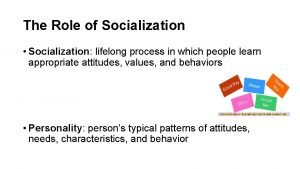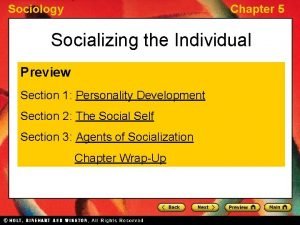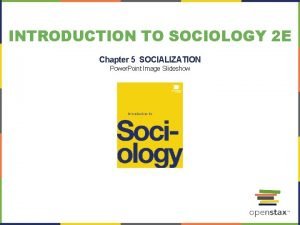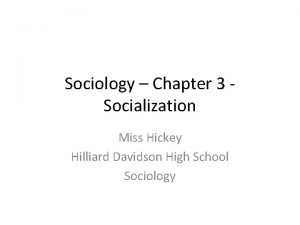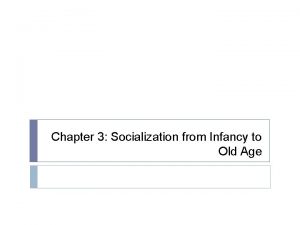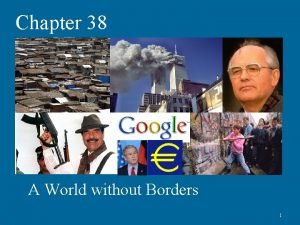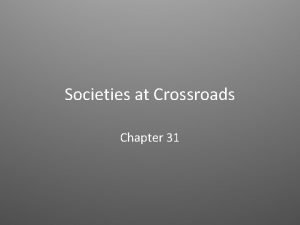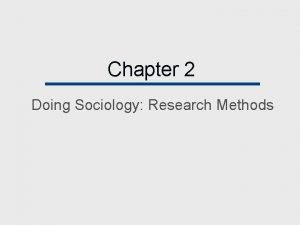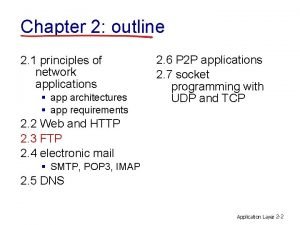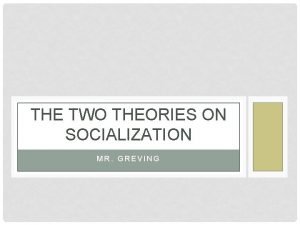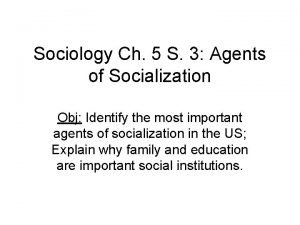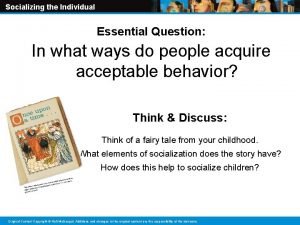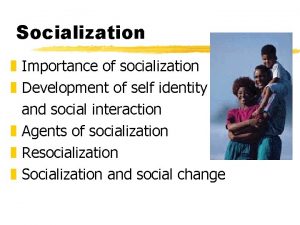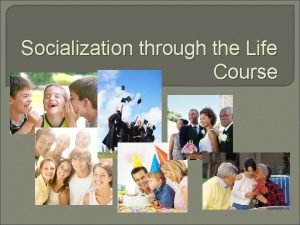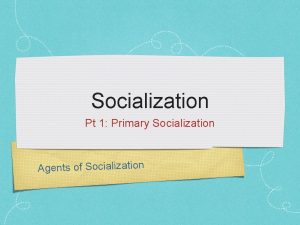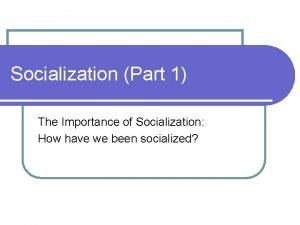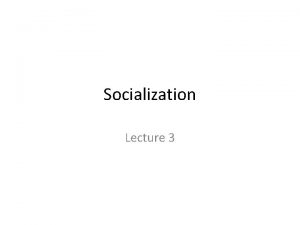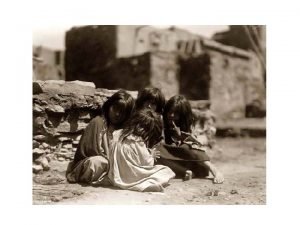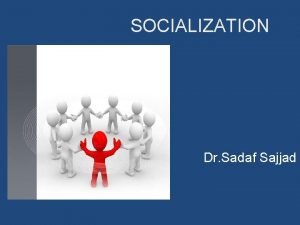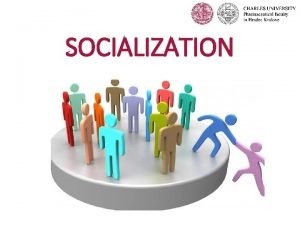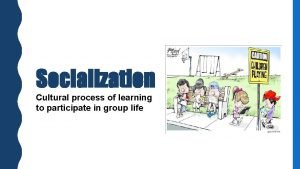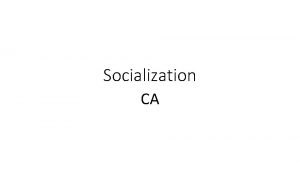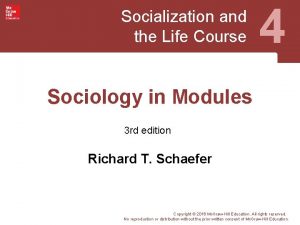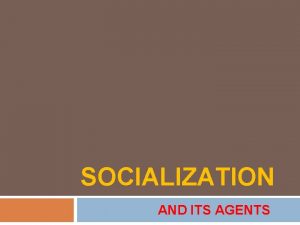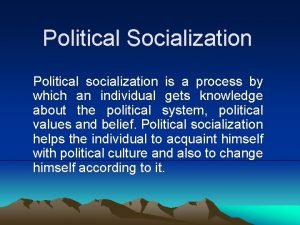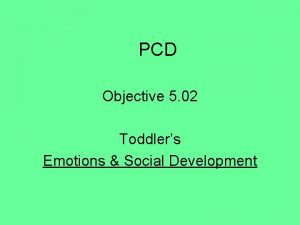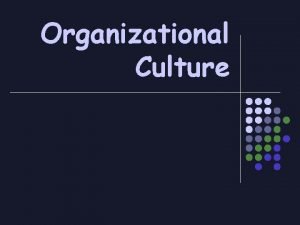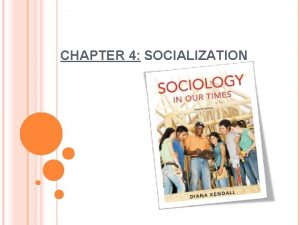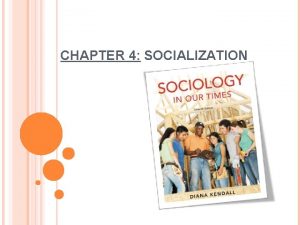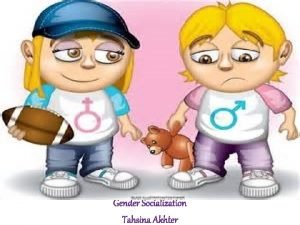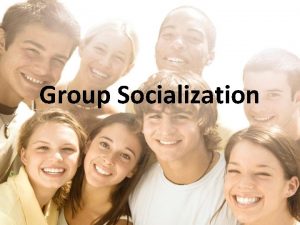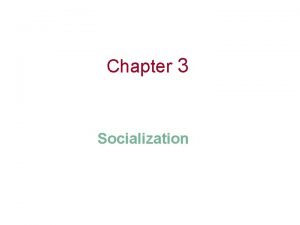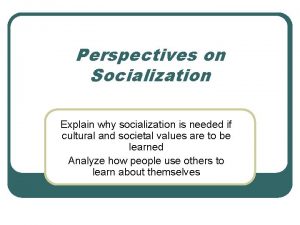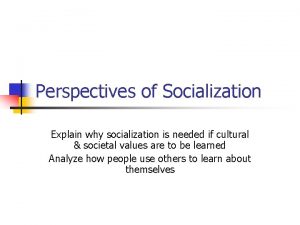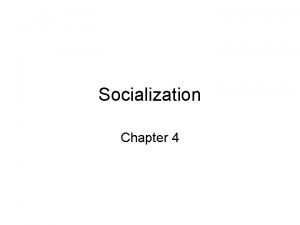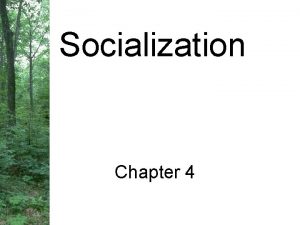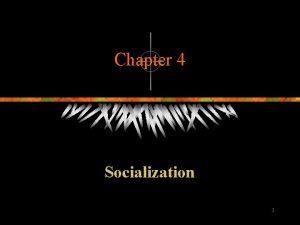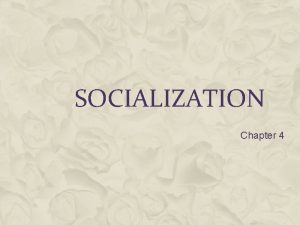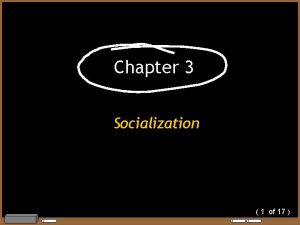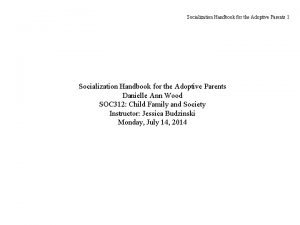Chapter 4 Socialization Chapter Outline Why Is Socialization

























































- Slides: 57

Chapter 4 Socialization

Chapter Outline § § § Why Is Socialization Important Around the Globe? Social Psychological Theories of Human Development Sociological Theories of Human Development

Chapter Outline § § § Agents of Socialization Gender and Racial-Ethnic Socialization Through the Life Course Resocialization Socialization in the Future

Socialization § § The lifelong process of social interaction through which individuals acquire a self identity and the physical, mental, and social skills needed for survival in society. Socialization is the essential link between the individual and society.

Why Socialization Is Important § § § Teaches us ways to think, talk and act that are necessary for social living. Ensures that members of society are socialized to support the existing social structure. Allows society to pass culture on to the next generation.

How Much Do You Know About Early Socialization and Child Care? True or False ? § In the United States, full-day child care often costs as much per year as college tuition at a public college or university.

How Much Do You Know About Early Socialization and Child Care? § True. § Full-day child care typically costs between $4, 000 and $10, 000 per child per year, which is as much or more than tuition at many public colleges and universities.

How Much Do You Know About Early Socialization and Child Care? True or False? § The cost of child care is a major problem for many U. S. families.

How Much Do You Know About Early Socialization and Child Care? § True. § Child care outside the home is a major financial burden, particularly for the one out of every three families with young children but with an income of less than $25, 000 a year.

Human Development § • • Each of us is a product of two forces: 1. Heredity- “nature” 2. the social environment -“nurture. ” Biology dictates our physical makeup. The social environment largely determines how we develop and behave.

Question § _____ is the lifelong process of social interaction through which individuals acquire a self-identity. a. Human development b. Socialization c. Behavior modification d. Imitation

Answer: b § Socialization is the lifelong process of social interaction through which individuals acquire a self-identity.

Freud’s Theory of Personality

Freud’s Theory of Personality § Human development occurs in three states that reflect different levels of personality: § Id § Ego § Superego

Erikson and Psychosocial Development: 8 Stages § According to Erikson, each stage is accompanied by a crisis that involves transitions in social relationships: 1. Trust versus mistrust (birth to age one). 2. Autonomy versus shame and doubt (1 to 3). 3. Initiative versus guilt (3 to 5). 4. Industry versus inferiority (6 to 11).

Erikson and Psychosocial Development 5. Identity versus role confusion (12 to 18). 6. Intimacy versus isolation (18 to 35). 7. Generativity versus self-absorption (35 to 55). 8. Integrity versus despair (maturity and old age).

Piaget’s Stages of Cognitive Development 1. 2. Sensorimotor stage (birth to age 2) children understand the world through sensory contact and immediate action. Preoperational stage (age 2 to 7) children begin to use words as symbols and form mental images.

Piaget’s Stages of Cognitive Development 3. 4. Concrete operational stage (7 to 11) children think in terms of tangible objects and events. Formal operational stage (12 and up) adolescents begin to think about the future and evaluate different courses of action.

Kohlberg’s Stages of Moral Reasoning 1. 2. Preconventional level (7 to 10) Children’s perceptions are based on punishment and obedience. Conventional level (10 to adult) People are concerned with how they are perceived by peers and how one conforms to rules.

Kohlberg’s Stages of Moral Reasoning 3. Postconventional level (few adults reach this stage) People view morality in terms of individual rights; “moral conduct” is judged by principles based on human rights that transcend government and laws.

Gilligan’s Stages of Female Moral Development § § § Stage 1: A woman is motivated primarily by selfish concerns. Stage 2: She recognizes her responsibility to others. Stage 3: She makes a decision based on a desire to do the greatest good for self and for others.

Question § According to Sigmund Freud, the _____ consists of the moral and ethical aspects of personality. a. id b. ego c. super ego d. libido

Answer: c § According to Sigmund Freud, the super ego consists of the moral and ethical aspects of personality.

Self-concept § § Self-concept is the totality of our beliefs and feelings about ourselves. Four components make up our self-concept: 1. the physical self (“I am tall”) 2. the active self (“I am good at soccer”) 3. the social self (“I am nice to others”) 4. the psychological self (“I believe in world peace”)

The Looking-Glass Self Stage 1: We imagine how we look to others:

The Looking-Glass Self Stage 2: We imagine how other people judge the appearance that we think we present:

The Looking-Glass Self If we think the evaluation is favorable our self-concept is enhanced.

The Looking-Glass Self If we think the evaluation is unfavorable our self-concept is diminished.

Mead and Role-taking The self is divided into “I” and “Me”: § “I” represents the unique traits of each person. § “Me” is composed of the demands of others and the awareness of those demands. § “I” develops first. “Me” is formed during three stages of self development.

Mead’s Three Stages of Self-Development 1. 2. Preparatory Stage (up to age 3) Children prepare for role-taking by imitating the people around them. Play Stage (3 - 5) Children begin to see themselves in relation to others.

Mead’s Three Stages of Self-Development 3. Game Stage (early school years) Children understand their social position and the positions of those around them. Children become concerned about the demands and expectations of others.

Agents of Socialization § § Family Peer Group School Mass Media

Peer Groups § § § A peer group is a group of people who are linked by common interests, equal social position, and (usually) similar age. Peer groups function as agents of socialization by contributing to our sense of “belonging” and our feelings of self-worth. Peer groups provide children with an opportunity for successful adaptation to situations such as gaining access to ongoing play, protecting shared activities

Question § Which agent of socialization do you think is the most responsible for gender differences in how males and females are socialized? a. The family b. Religion c. The peer group d. Education e. Mass media

Functionalist Perspective: Functions of Schools 1. 2. 3. 4. Teach students to be productive members of society. Transmit culture. Social control and personal development. Select, train, and place individuals on different rungs in society.

Conflict Perspective: Schools § § § Experiences depend on social class, racial–ethnic background, gender, and other factors. Children learn to be neat, punctual, quiet, wait their turn, and remain attentive to their work. Schools socialize children for later roles in the work force.

Media As Socializing Agents 1. 2. 3. 4. 5. Inform us about events. Introduce us to a variety of people. Provide an array of viewpoints on current issues. Make us aware of products that will supposedly help us. Entertain us.

Question § Which media source do you think has the strongest impact on attitudes and behaviors of your generation? a. Advertising b. Television c. Music and music videos d. The Internet e. Magazines

Gender Socialization § § The aspect of socialization that contains specific messages and practices concerning the nature of being female or male in a specific group or society. Important in determining what we think the “preferred” sex of a child should be and in influencing our beliefs about acceptable behaviors for males and females.

Racial Socialization § The aspect of socialization that contains specific messages and practices concerning the nature of one’s racial or ethnic status as it relates to : § personal and group identity § Intergroup and interindividual relationships § position in the social hierarchy

Socialization Through the Lifecourse § § Each time we experience a change in status (becoming a college student or getting married), we learn a new set of rules, roles, and relationships. Before we achieve a new status, we often participate in anticipatory socialization, the process by which knowledge and skills are learned for future roles.

Occupational Socialization § Sociologist Wilbert Moore divided occupational socialization into four phases: 1. Career choice. 2. Anticipatory socialization (learning aspects of the occupation before entering it). 3. Conditioning and commitment (learning the occupation and committing to it). 4. Continuous commitment (remaining committed even when problems arise).

Social Devaluation § § When a person or group is considered to have less social value than other persons or groups. Social devaluation is especially acute when people are leaving roles that have defined their sense of social identity and provided them with meaningful activity.

Resocialization § § § Learning a new set of attitudes, values, and behaviors. Resocialization is voluntary when we assume a new status of our own free will. Involuntary resocialization occurs against a person’s wishes and generally takes place within a total institution. § Military boot camps, jails, concentration camps, and some mental hospitals are total institutions.

Question § All of the following are examples of voluntary resocialization, except: a. becoming a student. b. going to prison. c. becoming a Buddhist. d. joining Alcoholics Anonymous.

Answer: b § Going to prison is not an example of voluntary resocialization.

Quick Quiz

1. Socialization is essential for: a. the individual's survival and for human development. b. all of the choices. c. the survival and stability of society. d. society to learn how to reproduce itself.

Answer: b § Socialization is essential for the individual's survival and for human development, the survival and stability of society and for society to learn how to reproduce itself.

2. The lifelong practice of social interaction through which individuals acquire a selfidentity and the physical, mental, and social skills needed for survival in society is called: a. socialization b. sociological imagination c. acculturation d. assimilation

Answer: a § The lifelong practice of social interaction through which individuals acquire a selfidentity and the physical, mental, and social skills needed for survival in society is called socialization.

3. Kohlberg's research classified moral reasoning into three sequential levels as follows: a. id, ego, superego b. imagination, imitation, and simulation c. preparatory, play, game d. preconventional, postconventional

Answer: d § Kohlberg's research classified moral reasoning into three sequential levels as follows preconventional, postconventional.

4. The ____ by Charles Horton Cooley refers to the way in which a person's sense of self is derived from the perceptions of others. a. generalized other b. reference group self c. looking glass self d. ego

Answer: c § The looking glass self by Charles Horton Cooley refers to the way in which a person's sense of self is derived from the perceptions of others.

5. Agents of socialization include: a. mass media b. school c. all of the choices d. the family

Answer: c § Agents of socialization include the mass media, school, and the family.
 Why why why why
Why why why why Dont ask why why why
Dont ask why why why Looking glass self examples
Looking glass self examples Gender socialization is a lifelong process
Gender socialization is a lifelong process Example of a quote sandwich
Example of a quote sandwich Outline why
Outline why Socializing the individual section 3
Socializing the individual section 3 Sociology chapter 5 socialization
Sociology chapter 5 socialization Hickey color stages
Hickey color stages Chapter 4: socialization, interaction, and the self
Chapter 4: socialization, interaction, and the self Chapter 3 socialization
Chapter 3 socialization Why-why analysis
Why-why analysis Why do you cry willy
Why do you cry willy Does the table represent a function why or why not
Does the table represent a function why or why not Does this table represent a function why or why not
Does this table represent a function why or why not Why or why not
Why or why not Contoh root cause
Contoh root cause What's labeling theory
What's labeling theory Romans outline by chapter
Romans outline by chapter Research proposal
Research proposal Give me liberty chapter 27 outline
Give me liberty chapter 27 outline Methodology chapter outline
Methodology chapter outline Chapter 38 a world without borders outline
Chapter 38 a world without borders outline Vbscript
Vbscript Chapter 16 hunger games questions
Chapter 16 hunger games questions Chapter 31 societies at crossroads outline
Chapter 31 societies at crossroads outline General hero
General hero Advantages and disadvantages of sociology
Advantages and disadvantages of sociology Chapter 1 outline
Chapter 1 outline Chapter 1 outline
Chapter 1 outline Chapter 30
Chapter 30 Chapter 2 outline
Chapter 2 outline The book of acts outline
The book of acts outline 24 chapter outline
24 chapter outline 24 chapter outline
24 chapter outline Forty niners apush
Forty niners apush Tabula rasa theory
Tabula rasa theory Cartoon political socialization
Cartoon political socialization What is meant by resocialization
What is meant by resocialization Deliberate socialization
Deliberate socialization Resocialization
Resocialization Importance of socialization
Importance of socialization 6 agents of socialization
6 agents of socialization Socialization through the life course
Socialization through the life course Agents of socialization
Agents of socialization Sociolazation
Sociolazation Types of socialization
Types of socialization Synonym for socialization
Synonym for socialization Example of anticipatory socialization
Example of anticipatory socialization Desocialization sociology definition
Desocialization sociology definition Define socialization
Define socialization The cultural process of learning to participate in a group
The cultural process of learning to participate in a group Types of socialization
Types of socialization Anticipatory socialization
Anticipatory socialization What is the agent of socialization
What is the agent of socialization Importance of political socialization
Importance of political socialization Socialization of toddlers worksheet answers
Socialization of toddlers worksheet answers Entry socialization options
Entry socialization options


